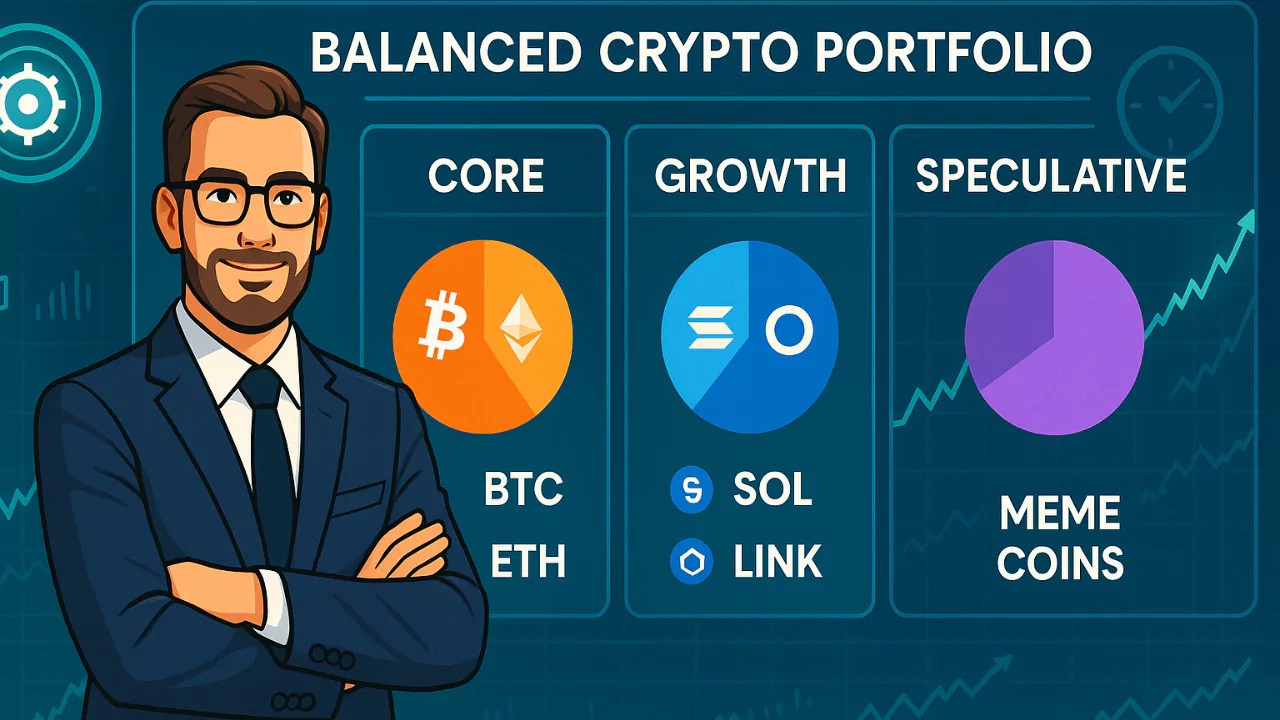A crypto portfolio is a collection of different digital assets like Bitcoin, Ethereum, and altcoins that you hold to achieve financial returns. It’s similar to a traditional stock portfolio but with higher volatility, unique opportunities, and the potential for outsized gains.
While short-term trading chases quick profits, long-term investing focuses on building sustainable wealth over time. In 2025 and beyond, as global crypto adoption continues to grow, creating a well-structured, long-term portfolio is not just smart—it’s necessary.
This guide breaks down how to build a solid long-term crypto portfolio step by step, from understanding basic strategies to asset allocation, security, taxes, and real-world examples.
Understanding the Basics
What Is a Crypto Portfolio?
A crypto portfolio is a personalized collection of digital assets—including cryptocurrencies, stablecoins, and occasionally tokens tied to emerging sectors such as DeFi, artificial intelligence, or blockchain-based gaming. Its primary purpose is to manage risk while targeting consistent long-term returns.
In many ways, it functions like a traditional investment portfolio, but with higher volatility and faster-moving markets. While traditional investors might hold stocks, ETFs, or bonds, crypto investors assemble portfolios of digital assets that may appreciate based on technology adoption, protocol upgrades, tokenomics, or broader market sentiment. If constructed thoughtfully, a crypto portfolio becomes a strategic roadmap toward wealth accumulation, offering a blend of security and growth potential.
Long-Term vs. Short-Term Strategies
| Strategy Type | Focus | Risk | Time Commitment |
| Short-Term | Day trading, swing trading | High | High |
| Long-Term | Buy-and-hold | Moderate to high | Low |
Short-term strategies rely heavily on timing the market, technical analysis, and quick decision-making. They can be lucrative but often come with high risk, stress, and transaction fees. Long-term strategies, on the other hand, involve buying fundamentally strong assets and holding them over months or years to ride out volatility and benefit from larger macro trends.
For beginners, long-term investing is a safer entry point into crypto. It minimizes emotional trading, reduces exposure to short-term market noise, and allows you to benefit from compounding returns and long-term growth in blockchain adoption.
Defining Your Crypto Investment Goals
Clarify Your Financial Goals
Start by understanding the core reason you’re investing in crypto. Are you saving for retirement, building long-term wealth, seeking passive income, or trying to preserve capital against inflation? Each of these goals has a different risk profile and time horizon.
Once your intent is clear, define your goals using the SMART framework: Specific, Measurable, Achievable, Relevant, and Time-bound. For example, instead of saying, “I want to make money with crypto,” set a goal like: “Grow my crypto portfolio by 150% over the next five years by investing in top-tier assets and reinvesting returns.”
Know Your Risk Tolerance
Everyone has a different capacity for risk, influenced by income level, financial obligations, and investment experience. Use online risk profiling tools or consult with a financial advisor to gauge whether you are conservative, moderate, or aggressive.
A conservative investor may prefer holding Bitcoin, Ethereum, and stablecoins—assets with relatively lower volatility and higher trust. A moderate investor might include high-quality altcoins with growing ecosystems. Aggressive investors may allocate part of their portfolio to micro-cap or early-stage projects with moonshot potential, fully aware of the risks involved.
Understanding your risk appetite not only helps in asset selection but also determines how you emotionally respond to market downturns. Matching your portfolio to your risk profile helps you stay the course during turbulent phases.
Investment Time Horizon
Crypto is highly cyclical, with bull and bear markets that can last years. A solid time horizon helps you stay focused during downturns and avoid panic selling. Are you investing for three years, five years, or a decade?
The longer your horizon, the better your ability to ride out market corrections and take advantage of compounding returns. Investors who can wait patiently often outperform those who trade frequently. Remember: time in the market usually beats timing the market, especially in crypto.
Portfolio Structure and Allocation
The 3-Layered Crypto Portfolio Model
A structured portfolio ensures diversification and aligns with your risk profile. A popular approach is the 3-layer model:
| Layer | Allocation | Asset Type | Risk Level |
| Core | 60–70% | Bitcoin, Ethereum | Low |
| Growth | 20–30% | Altcoins (e.g., Solana, Chainlink) | Medium |
| Speculative | 5–10% | Meme coins, micro-caps | High |
The core layer focuses on proven, large-cap assets that are expected to hold or grow in value over the long term. These are the backbone of your portfolio, typically offering stability and steady appreciation. The growth layer introduces promising altcoins with active development and real-world utility. These projects often carry higher risk but offer better upside potential.
The speculative layer carries the highest risk but also the potential for exponential gains. This is where you place early bets on innovative projects that are still under the radar. This structure helps manage overall risk while giving you exposure to various parts of the crypto ecosystem.
Diversification
Diversification protects your portfolio from severe losses when individual assets underperform. Spread your investments across:
- Market capitalizations: large-cap (BTC, ETH), mid-cap (LINK, SOL), and small-cap tokens
- Sectors: DeFi, infrastructure, gaming, AI, NFTs, Layer 2 scaling
- Blockchain ecosystems: Ethereum, Solana, BNB Chain, Avalanche
While diversification is important, don’t go overboard. Holding too many assets can become difficult to manage and dilute your performance. Focus on quality over quantity. A balanced portfolio of 10–15 well-researched tokens gives you enough exposure without overwhelming complexity.
Stablecoins and Cash Position
Holding a portion of your portfolio in stablecoins such as USDT, USDC, or BUSD offers flexibility. A 5–10% cash position allows you to act on market dips without liquidating your core holdings.
It also provides downside protection and helps reduce overall portfolio volatility. In a bear market or during high uncertainty, this cash buffer can be a strategic advantage. Stablecoins also make it easier to shift funds quickly between assets or move them off-exchange into cold storage when needed.
Research and Selection Strategy
Fundamental Analysis
Evaluate each crypto project thoroughly:
- Team: Are they credible and experienced?
- Use-case: Real-world problem-solving?
- Tokenomics: Supply, inflation, utility?
- Partnerships: Any big names backing it?
Whitepaper checklist:
- What problem is it solving?
- How does the tech work?
- What is the roadmap?
- How is the token used?
Technical Analysis (for Entry Points)
While not essential for long-term investing, technical analysis helps you buy smart. Focus on:
- Support/resistance zones
- 50-day/200-day moving averages
These help you avoid buying tops and buy during consolidations.
Sentiment and Market Trends
Use on-chain metrics to gauge market mood:
- NVT Ratio: Is the asset overvalued?
- Active Wallets: Is usage growing?
- Social Trends: Is interest rising?
Tools to use:
- Glassnode
- Santiment
- LunarCrush
Where and How to Buy Crypto Safely
Choosing the Right Exchange
- Centralized Exchanges (CEXs): Binance, Coinbase, Kraken (Ideal for beginners)
- Decentralized Exchanges (DEXs): Uniswap, PancakeSwap (More control, but higher complexity)
If you want to know more about CEX and DEX, visit cryptowealthnet.
Fiat On-Ramp Methods
You can buy crypto using:
- Credit/debit cards
- Bank transfers
- Peer-to-peer (P2P) marketplaces
Make sure the exchange is regulated and offers 2FA security.
Dollar-Cost Averaging (DCA)
Instead of timing the market, use DCA:
- Invest a fixed amount weekly or monthly
- Reduces emotional buying
- Smooths out volatility
Example Strategy: Buy $100 worth of BTC every Monday for 2 years.
Safe Storage and Security for Crypto
Custodial vs. Non-Custodial Wallets
| Wallet Type | Examples | Who Holds the Keys? |
| Hot Wallets | MetaMask, Trust Wallet | You |
| Cold Wallets | Ledger, Trezor | You |
| Custodial | Exchange wallets | They do |
Use cold wallets for long-term storage and hot wallets for regular use.
Security Tips
- Use strong, unique passwords
- Enable 2FA
- Never share your seed phrase
- Beware of phishing links
- Backup wallet recovery info securely
Portfolio Tracking and Management
Use of Portfolio Trackers
Top tools include:
- CoinStats
- Delta
- CoinMarketCap portfolio
- Excel/Google Sheets
Rebalancing Strategies
Rebalancing means adjusting your portfolio back to target allocations.
When to rebalance:
- Every 3–6 months (calendar-based)
- When an asset moves ±10% from target (threshold-based)
Keeping Up with Project Developments
Stay updated via:
- Twitter/X
- GitHub repositories
- Discord/Telegram groups
- News sites like CoinDesk, The Block, Decrypt
Taxation and Compliance
Know Your Local Tax Rules
Crypto taxes vary by country, but common taxable events include:
- Selling crypto for fiat
- Trading one crypto for another
- Earning crypto as income
Check if it’s taxed as capital gains or income.
Crypto Tax Tools
Tools that simplify reporting:
- Koinly
- CoinTracker
- Accointing
They integrate with exchanges, generate tax reports, and save time.
Common Mistakes to Avoid
- Chasing FOMO pumps
- Selling in panic during crashes
- Overinvesting in one coin
- Storing large amounts on exchanges
- Ignoring due diligence
- Blindly following influencers
Sample Long-Term Crypto Portfolio (2025 Edition)
| Asset | Allocation % | Reason |
| Bitcoin (BTC) | 40% | Store of value, digital gold |
| Ethereum (ETH) | 30% | Smart contract leader |
| Solana (SOL) | 10% | Fast, scalable, strong dev activity |
| Chainlink (LINK) | 5% | Crucial for oracles and data feeds |
| Arbitrum (ARB) | 5% | L2 scaling solution with momentum |
| USDT/USDC | 5% | For buying dips or reducing risk |
| Micro-cap project | 5% | High-risk, high-reward moonshot |
Staying Committed for the Long Run
Mindset and Patience
Crypto markets are volatile. Expect:
- 70% drawdowns
- Sudden rallies
- Extreme FUD and hype
Stay calm, focused, and remind yourself of the long-term vision.
Learn Continuously
Crypto evolves fast. Keep learning:
- Read whitepapers
- Follow experts like Vitalik Buterin, Chris Burniske
- Take online courses (Coursera, Binance Academy, Moralis)
Conclusion
Building a long-term crypto portfolio is a strategic decision that requires patience, discipline, and a clear understanding of your financial goals. It’s not about chasing quick gains, but about creating a foundation that can grow steadily over time.
A well-structured portfolio, based on research and aligned with your risk tolerance, helps you stay grounded during both market highs and lows. Long-term investing doesn’t mean doing nothing—it means making smart choices consistently, managing risk carefully, and staying informed as the crypto space continues to evolve.
In the end, success in crypto comes to those who think long term, stay committed, and allow time and compounding to do their work.

































